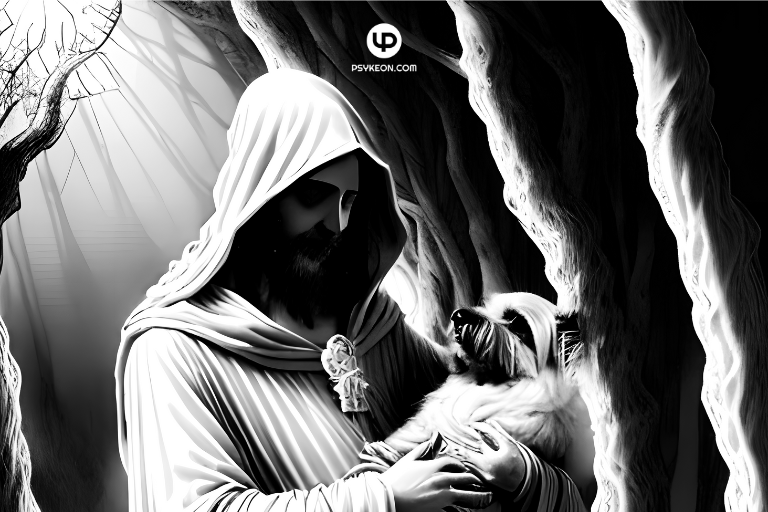It happened in a matter of days.
She went from being a joyful and lively 16 years old dog, to receiving both a heart and kidney failure diagnosis, and losing her abilities to walk.
Dogs are often portrayed in mythology as psychopomps, or the beings that guide the spirit of the dead into the afterlife, but in this case, we were first going to be hers.
Now, humans have always populated the Earth alongside animals, and our view of them and nature has, naturally, changed overtime.
For an important part of pre-history, humans were but a miniscule and vulnerable part of nature.
Indeed, many wild animals and plants can provide food, but many can also kill.
The domestication of animals and cattle, a process that spanned thousands of years, is a central step in attempting to harness and work with some of the powers of nature.
No longer did humans need to solely rely on risking their lives hunting animals for food, and could also develop relationships with them, be it to provide meat more easily, as workers, or as companions.
Familiars and Western Esotericism
Animal familiars hold a significant place in the esoteric and spiritual history of the West, serving, through the power of symbolic correspondences, as the spiritual guides, protectors, and mediators between wise folk and the supernatural worlds.
It is well known that animals make up the vast majority of all prehistoric cave paintings throughout the Old Continent. The general consensus tends to be that these paintings represented shamanic invocations to the natural world. The shaman, secluded deep in the cave, is said to have entered an altered state of consciousness in which he connected with the spirit of the animals, invoking their benevolence in hunting and fertility through the rupestrian images.
Druids, the nature-revering spiritual leaders of the Gauls, saw animals as sacred beings capable of providing divine messages, and often invoked their symbolism into their rituals. For example, the raven was considered a symbol of prophecy, integral to divination practices, the stag or boar was related to strength, fertility, and connection to the natural world, and the wolf symbolized the guardian of the wilderness and primal forces.
In Western Esotericism, particularly during the medieval and Renaissance periods, familiars, such as the black cat and toad, were believed to be spirits in animal form assisting witches, wizards and cunning folk (traditional healers) in their craft, such as by providing protection and aiding in spell casting, divination and in providing healing. Nevertheless, in the case of witches and wizards, they were often believed by non-initiated to be demons bound to their masters by a pact, and aiding their supposedly evil pursuits.
Why am I mentioning all this?
Because not only do humans have a very long history of helping relationships with animals, but also that this link is a sacred one, just as a human relationship is…
…Whether the animal is alive as a companion, or in spirit form as a familiar.
The Rise of Anthropocentrism
We can see a significant shift in thought in the Jewish Torah and Christian Bible:
“Then God said, ‘Let us make man in our image, after our likeness. And let them have dominion over the fish of the sea and over the birds of the heavens and over the livestock and over all the earth and over every creeping thing that creeps on the earth.’” Genesis 1:26
Humans are not seen as a part of nature, but as superordinate to it. It is nature that should fear us, says the Bible:
“The fear of you and the dread of you shall be upon every beast of the earth and upon every bird of the heavens, upon everything that creeps on the ground and all the fish of the sea. Into your hand they are delivered. Every moving thing that lives shall be food for you. And as I gave you the green plants, I give you everything.” Genesis 9:2-3
Most anthropologists describe this as the beginning of anthropocentrism, the idea that humans are the central and most important species on Earth.
Usually, this attitude has three manifestations:
- Perceptual Anthropocentrism, or the main reliance on human senses to gather data.
- Descriptive Anthropocentrism, or the ordering of ideas and concepts around humans.
- Normative Anthropocentrism, or the positioning of humans as superior to the rest of the universe.
These sentiments took roots in the Middle Ages, were further reinforced during the scientific revolution and the Age of Enlightenment, and came to dominate today’s Western philosophy, science, and society in general.
The Last Moment
In this spirit, whereas most deceased humans are usually carried to the other world through solemn and individualized funerary rites, I have always heard about pets being taken away by the vet to be euthanized alone, then mass cremated, and the ashes split between the individual owners, irrespective of the remains’ provenance.
It was therefore a bitter-sweet surprise to hear about at-home euthanasia services for pets, as well as having the vet tell us about their ceremonial pet cremation and burial services.
In her last moments, our dog laid on her favorite blanket on my mother’s lap, her breathing labored.
We gave her a last piece of cake as the vet prepared the deadly yet painless concoction.
She didn’t even react to the needle going into her rear paw; her breathing increased only for a few seconds, before slowly stopping.
She left, surrounded by her entire family, and with the taste of sweets in her mouth.
Draped in a warm blanket, we offered her a last walk around the house.
We learned that she would be carried to the pet morgue, where her body would be embalmed for a wake, and the subsequent individual cremation.
We would also get prints of her snout and paws, clippings from each of the different sections of her fur, as well as her own ashes in a white urn decorated with paw prints.
“It’s just a pet” some would say, but that’s just being blinded by anthropocentrism, an attempt at reaffirming one’s superiority as a species in the face of death.
Textbook example of Terror Management Theory at play.
She was a member of the family, and will be treated as one both in life and in death.
The Pet Resting Place
And so, about a week later, we drove an hour to the arranged location.
A small cabin was standing next to a barn, in the middle of a vast field surrounded by a forest.
We were quite far from the city. “A perfect resting place!” I said.
We waited a bit under a large oak tree, as the grave keeper was tending to another grieving family.
We wanted to see her, but at the same time we knew that despite already being dead, it would be the last time ever.
And our turn came.
We made our way into the cabin and saw a wicker basket covered with a blanket, a kleenex box on the side.
We slowly pulled away the cover to reveal her peaceful little face; it looked like the best sleep one could wish for.
We petted her so much that her big ears defrosted.
After saying our goodbyes for a good 15 minutes, we watched the grave keeper lay her body on the slab. He brought her towards the cremation oven, but I must admit, we did not have the gut to watch the process, and quickly exited the building once the metal opened and the flames raged.
With an hour to wait, we slowly cruised along the small country roads, reminiscing about her more-than-perfect life. And her death, although so unfair, was a perfect, peaceful ending to her story.
We made our way back to the resting place; one last step before the next chapter of our lives.
The man handed us the mementos, and wished us a meaningful grieving. We shook hands and thanked him.
Sitting in the car on the way back, we all felt lighter, and ready to face the emptiness that now was.
It’s crazy how looking beyond anthropocentrism can actually help both animals and humans.
The next day, as I went to rest the silk baggie with her hair clippings on my Bible, I noticed something on my Holy Book… a leftover chocolate egg from Easter.
“My little glutton is still there”.
Rest well dear friend, you went from being a trusted companion, to now, a trusted familiar.
Look upon us from the other world, and wait for us.
References
Alberta’s Energy Heritage. (n.d.). Animal Power in prehistoric times. Animal Power in Prehistoric Times – Electricity & Alternative Energy. http://www.history.alberta.ca/energyheritage/energy/human-and-animal-power/animal-power-in-prehistoric-times/default.aspx
The Bible (ESV)
Clottes, J. (2024, July 5). cave art. Encyclopedia Britannica. https://www.britannica.com/art/cave-art
Greenberg, J., & Kosloff, S. (2008). Terror management theory: Implications for understanding prejudice, stereotyping, intergroup conflict, and political attitudes. Social and Personality Psychology Compass, 2(5), 1881–1894. https://doi.org/10.1111/j.1751-9004.2008.00144.x
Mylius, B. (2018). Three types of anthropocentrism. Environmental Philosophy, 15(2), 159–194. https://doi.org/10.5840/envirophil20184564
Wikipedia contributors. (2024, July 11). Cunning folk. In Wikipedia, The Free Encyclopedia. Retrieved 00:37, August 8, 2024, from https://en.wikipedia.org/wiki/Cunning_folk
Wikipedia contributors. (2024, July 31). Familiar. In Wikipedia, The Free Encyclopedia. Retrieved 00:37, August 8, 2024, from https://en.wikipedia.org/wiki/Familiar



